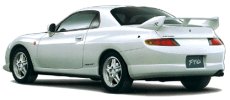 Isn’t
it sound strange to you ? 3 years after launch AutoZine still reports
the
FTO. Wait a moment. The FTO report was always here since the establish
of AutoZine in 1997, however, it was always lack of a decent review to
FTO’s real world performance. Why ? because Mitsubishi didn’t export it
to other English-speaking countries which are capable to test drive the
car SERIOUSLY until recently. Now it is available in UK via
RalliArt. Isn’t
it sound strange to you ? 3 years after launch AutoZine still reports
the
FTO. Wait a moment. The FTO report was always here since the establish
of AutoZine in 1997, however, it was always lack of a decent review to
FTO’s real world performance. Why ? because Mitsubishi didn’t export it
to other English-speaking countries which are capable to test drive the
car SERIOUSLY until recently. Now it is available in UK via
RalliArt.
Today, its exterior styling is still odd to me, though not as unacceptable as 3 years ago. I know many may disagree with me and describe the FTO as a beauty. Well, I’d say it is "special" but never "handsome" if judging according to our traditional artistic view. 3 years ago the interior design and finish were OK, but today they are obviously outdated. The all-black cabin lacks any sparkle or any sense of occasion. The dashboard and center console design tries to be sporty but lack of the elegant detailing of today’s rivals, such as alloy-color panels, carbon fiber inserts, retro air vent. / gauges or body-colored stripes. Everywhere is black plastic, especially is low grade one. Subjectively the cabin score the lowest marks but objectively it is another matter - the buckets are supportive, instruments are clear to read, controls are positioned ergonomically. The worst part is the better-to-forget rear seats, well, not very important for a coupe. Most unusual is the normally aspirated V6 engine which shares with the right-hand-drive Galant VR-M. While most rivals employ turbocharged engine or a large V6 with 2.5 to 3-litres displacement, FTO’s unit has just 2.0 litres. With the help of the effective MIVEC (cam-changing VVT) peak power reaches a maximum 200hp, that translate to a specific output of 100hp / litre. As usual, the 147 lbft of maximum torque is the result of the small capacity, and it emits at the highly 6,000rpm.
Handling is far better. First to be noted is the firm set-up of the suspensions leads to remarkable body roll resistance and very high cornering limit. Like the Integra Type R, the FTO suits the most demanding driver. The steering is accurate and quick. Due to the lack of torque, torque steer is anything but exist. However, as a FF its cornering is not as adjustable as the Silvia. Driving pleasure is also enhanced by the superb gearbox. It is still a 5-speeder, but shift slick and quick and has a short-throw shifter. Clutch is light yet progressive, a pure Japanese goodness. Real drivers are better to forget the Tiptronic box. Considering the
engine capacity
of only 2 litres, it is amazing to see such a performance even
eclipsing
the US-market Eclipse V6, which displaces a full litre more. Further
considering
the superior handling of FTO, it is a sad thing that Mitsubishi still
doesn’t
want to bring it to the US. Perhaps never. |
| The above report was last updated on 23 Aug 99. All Rights Reserved. |
 The
small V6 is extremely
smooth and revvy. It is a lovely engine, with linear power delivery and
sufficient punch at low speed. Anyway, in terms of performance it can’t
match the more torquey rivals. 0-60mph in 6.9 sec is still good enough,
but 0-100mph in 17.8 sec barely matches the 328Ci but trails the GTV
(16.0),
Fiat Coupe (14.5) and Silvia (14.2) by quite a large margin. Its
aggressive
look suggest more than that.
The
small V6 is extremely
smooth and revvy. It is a lovely engine, with linear power delivery and
sufficient punch at low speed. Anyway, in terms of performance it can’t
match the more torquey rivals. 0-60mph in 6.9 sec is still good enough,
but 0-100mph in 17.8 sec barely matches the 328Ci but trails the GTV
(16.0),
Fiat Coupe (14.5) and Silvia (14.2) by quite a large margin. Its
aggressive
look suggest more than that.